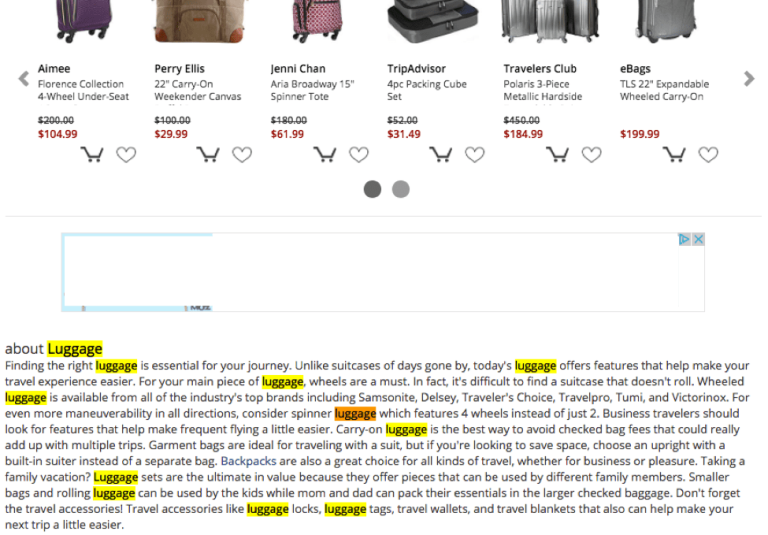

No matter how smart and hard retailers work to bring customers to their website and lead them throughout the shopping process, only three out of ten shopping carts will generate an order. That is a significant amount of lost revenue. It hurts double if the sale winds up going to your competition.
While all retailers find shopping cart abandonment a big issue, some see it as an opportunity to gain an advantage against the competition. In this blog, we’ll reveal why those issues emerge and how to address them.
Before diving into some solutions for cart abandonment, it is imperative to first know your brand’s cart abandonment rate.
How to calculate your shopping cart abandonment rate
Although the average cart abandonment rate in eCommerce varies based on the industry you are in, it usually is somewhere in the ballpark of 70%, (Baymard, 2019). Ecommerce sites with longer decision-making cycles such as travel can experience rates as high as 80%.
So, how do you determine the average cart abandonment for your brand? You can calculate it by using the formula below from Tidio:


The higher the cart abandonment rate, the greater the financial loss for the company. Unless you stop customers from leaving with solid solutions to either stay or come back and complete the order.
Here are the top cart recovery solutions you should consider:
Authenticate Your Brand with Social Proof
Consumers want to see more than just what you are selling. According to Stackla data, over 86% of digital consumers decide to support brands based on how authentic they are perceived to be. Additionally, 60% of these consumers believe that publishing user-generated content is the best way to show authenticity – insert blog content or social images that depict more than just your product. Given this data, one of the best shopping cart abandonment solutions to implement actually has nothing to do with the checkout process and has everything to do with you and how you present your brand.
You can take strides toward getting shoppers to trust your brand by offering real customer reviews and trust badges. Highlight these on your product pages and within your cart abandonment workflow. Another avenue is to use your social media accounts to encourage customers to share their experiences with your brand, both positive and negative. These two simple and low-cost strategies will go a long way in helping to reduce cart abandonment.
Retargeting ads using PPC
Retargeting/remarketing ads allow you to stay in front of interested individuals who may be close to converting. When a customer visits and leaves your website, a remarketing campaign displays your banner or text ad on other sites they visit, including social websites and apps. Remarketing campaigns drive prospective and previous customers back to your site, reducing shopping cart abandonment and providing better audience segmentation while building brand awareness. Delivering a specific message to your customer based on where they are in the buying cycle – in this case the Shopping Cart, though remarketing can be used earlier in the buying cycle as well -, and selecting imagery based on what pages they visited while on your site is key to delivering the highest possible ROI for your remarketing budget.
To optimize your remarketing efforts, it is also important to segment your customers in detail. You need to consider things such as; the item(s) they were purchasing before they left the site, the value of the item they abandoned, and whether they were a first-time customer or not. This can help you re-engage shoppers long after they’ve abandoned your site with the proper segmentation messaging that will likely increase your clicks and conversions. It can also help you increase profits and overall customer satisfaction.
To learn additional steps and strategies to help you get started with all forms of Search Engine Advertising, read our blogs 5 Ways an Integrated SEO PPC Strategy Will Benefit Your eCommerce Business and SEO and PPC: It’s Easy as 1,2,3.
Strike While the Iron is Hot with Automation
When using email automation workflows for cart recovery, timing is critical so you need to be sure you strike while the iron is hot; which is usually within one hour of abandonment. After the initial email has been sent, you can set up two or more to improve your chances of recapture – though it is important to remember here is not to overdo it.
With the right software or agency support/assistance, certain actions (or inactions) can trigger pre-crafted messages to send automatically to customers soon after they leave their carts behind.
Whether you decide to work with an agency or use software – your email automation should be able to do:
- Send automatic welcome emails when someone subscribes to your newsletter or creates an account on your site
- Allow for a behavioral trigger, like abandoning a cart or browsing a certain product category
- Engage your customer post-purchase with the order confirmation and shipping notifications
- Send automatic timed responses based on birthdays to nurture your customer relationship
- Create timed-based triggers to re-engage inactive customers
Key Concepts to Include in Your Automated Emails
Bringing in additional strategies into the mix will make your email campaign even more powerful and continue to decrease your cart abandonment rate. Some of these strategies include:
Feature the abandoned product in the email: remind your customer what they are missing out on by providing exact details; the image, size, color, and price of the item within your initial email. For subsequent emails, including recommendations for similar products might improve chances of conversion, as well. Worx has a great follow-up email that reminds customers what they left behind with additional item suggestions:
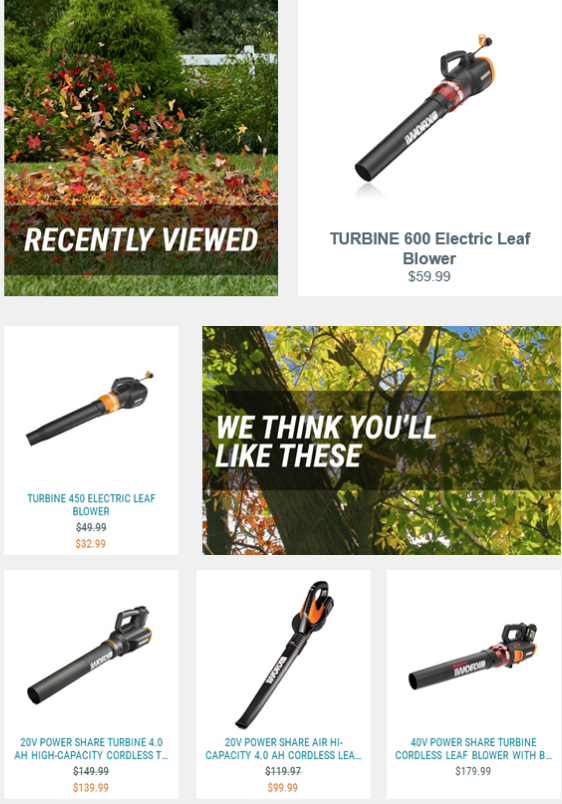

Use high converting subject lines: a catchy subject line like Perigold’s grabs your customer’s attention and helps increase open and click rates.


This is a strategy that can translate across all of your marketing strategies. Once you’ve come up with a catchy subject line, it is important to test them with sample audiences to find out what’s working and what’s not before you make a campaign live.
Our blog posts Subject Line Tactics and Email Best Practices dive deeper into testing subject lines and offer some tips and tools you can use to help increase your open rates.
Offer support: customers might abandon their cart because they had questions (i.e. return policy, sizing) or were having technical issues. Allow them to ask questions if they have them whether on your actual site or in your first email touchpoint. Saatchi Art does a good job in their follow-up email of highlighting where a customer can go for help should they have questions before they order:
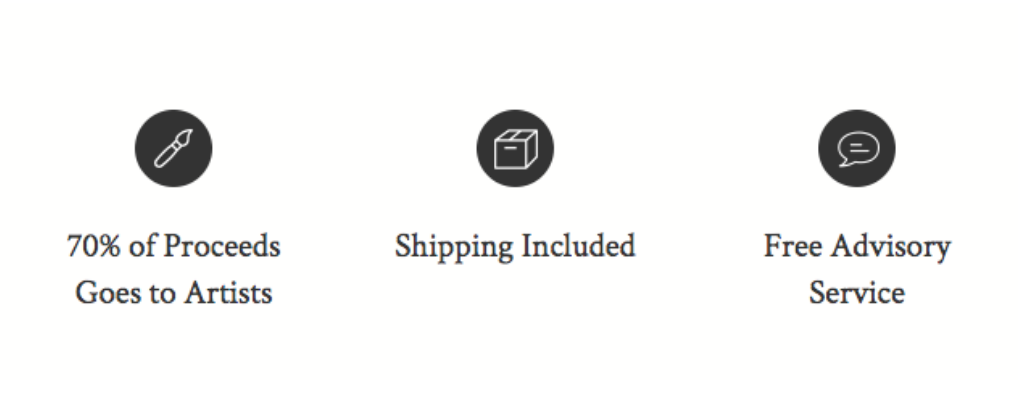

Offer incentives: regardless of the industry you are in, any good eCommerce or digital marketer knows that building a great email list is often done with some kind of incentive to sign up, like a discount or free shipping similar to the offer Saatchi Art provides in their follow-up email below. When you offer an incentive, either in a timed or an exit-intent pop-up, the welcome email will likely be opened immediately.
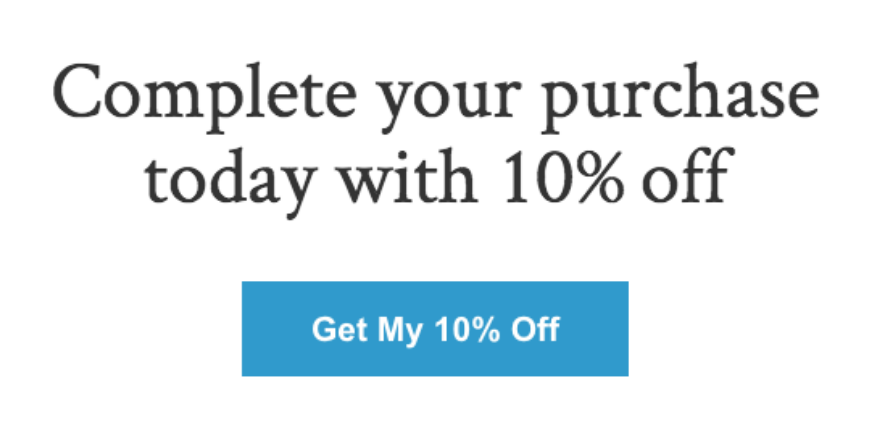

Have a clear CTA: put a bold, easy-to-see, contrasting CTA right below the product image that the customer left behind pushing them towards the action you want them to take; purchase the product. Specialized entices customers the item they left behind is worth a second look with their clear CTA:


Let’s break it all down with an example
As mentioned above, a catchy subject line or incentive will grab your customer to come back. Let’s look at the good and bad of the follow-up email below from Public Rec to help inspire your email automation campaign.
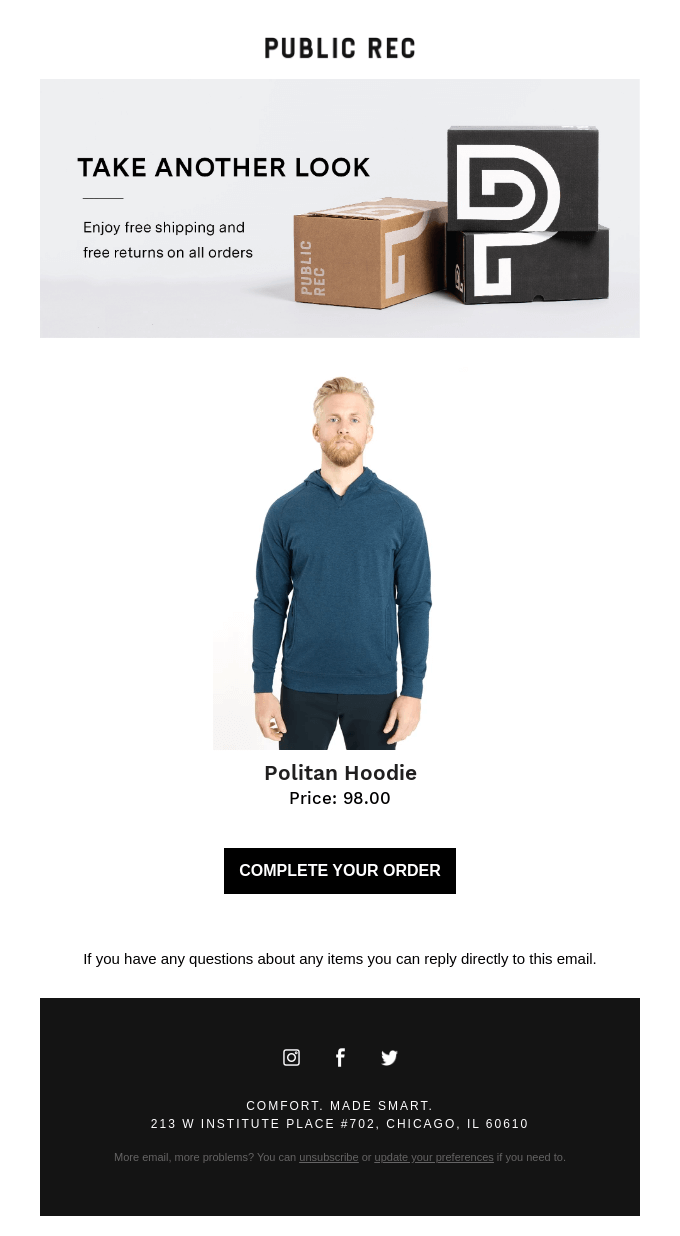

What is good about this automated email?
The subject line positively defines the abandoned product as worth another look for the shopper.
- While there is no discount, the verbiage used can be powerful enough to create a conversion.
- A distinct CTA is provided making it clear and obvious where to click and what action you want them to take.
- There is mention of FREE shipping costs. The cost of shipping is a top reason for abandoned carts and including that here could be powerful enough to create conversion.
- There is mention of FREE returns. Consumers want to feel confident in their order, especially first-time customers. Reinforcing whether or not you offer a return policy can make completing their purchase seem like a no-brainer.
What is bad about this automated email?
The subject line positively defines the abandoned product as worth another look for the shopper.
- There is NO customer service information. A link to a help page, live chat, or general phone number is not represented and could be useful to a customer.
- There are NO other product recommendations included in the email.
Bringing it all together
We understand that cart abandonment is a complex issue for all eCommerce businesses and there is no single solution that works across brands and industries. Overall, retailers need to understand the reasons behind why a shopper abandons their cart.
Do they simply need a reminder or do you need to offer a discount? Maybe it is the return policy that is the hurdle to overcome. Or maybe you need to provide product recommendations to increase their shopping cart to qualify for free shipping.
Creating an email strategy can help your customers overcome those concerns and bring shoppers back while also recovering baskets of money in revenue.
Are you ready to reduce your cart abandonment rate, boost conversions, and take your business closer to its maximum revenue potential? Connect with one of our experts today to discuss your eCommerce needs!
Get in Touch
Connect with one of our experts today to discuss your eCommerce needs!
Contact Us






